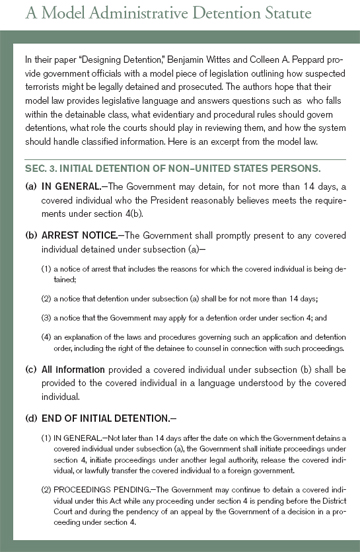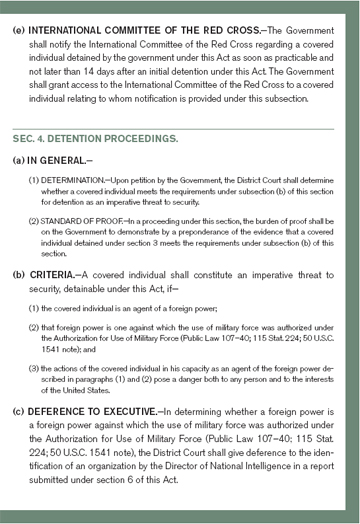- Security & Defense
- Terrorism
- US Defense
A consensus is beginning to emerge in the public and political spheres concerning the noncriminal detention of suspected terrorists. During the past several years, noncriminal detentions of Al-Qaeda and Taliban captives at Guantánamo Bay, Cuba, have sharply divided the American polity. Since the change in administration, however, it has become increasingly clear that the United States—even under a Democratic administration and with substantial Democratic majorities in both houses of Congress—is not going to abandon long-term detention of suspected terrorists and revert to a pure law enforcement model for incapacitating them, and it is not going to deal with the population of Guantánamo by freeing everyone whom it cannot prosecute. Although the developing consensus still has many dissenters, the real question now is not whether the United States will have some detention system but what sort of detention system it will have, who will design it, and what rules will be used.
In his May 21, 2009, speech at the National Archives on national security strategy and law, President Barack Obama placed himself solidly within this emerging body of thought. He recognized that protecting our national security may require a noncriminal detention system for terrorists who cannot be tried but who are too dangerous to release. And he made clear that this system needs to be fair and rigorous, supervised by the federal courts, and created by an act of Congress. The president called for a system that has “clear, defensible, and lawful standards,” “fair procedures so that we don’t make mistakes,” and “a thorough process of periodic review, so that any prolonged detention is carefully evaluated and justified.”
Much commentary and speculation have focused on the form that this new regime should take, rather than on the details of the many questions a detention regime will need to address. In the wake of the Supreme Court’s decision in ItalicsBoumediene v. ItalicsBush, in which a 5-4 majority held that Guantánamo Bay prisoners had a right to habeas corpus under the U.S. Constitution and that the Military Commissions Act of 2006 was an unconstitutional suspension of that right, it is inevitable that federal judges will ultimately oversee any such detention system. Aside from this one general feature, however, the framework for the new system remains wide open in any number of respects.
The need for a preventive detention apparatus is the result of the unique nature of America’s conflict with transnational terrorist organizations and the limits of existing laws, both international and domestic, in responding to current threats. Defense Secretary Robert Gates testified that, after Guantánamo closes, there will remain a residual group of fifty to one hundred Guantánamo detainees who cannot be tried yet are too dangerous to release. The structural issues that generated this group actually implicate a larger population than that currently held at Guantánamo. Any new detention regime will need to address not only Guantánamo detainees but also similar detainees held elsewhere and terrorists captured in the future outside zones of active military operations.
The debate over what to do both with these residual Guantánamo detainees and with future captives in global counterterrorism operations has largely focused on which legal regime should serve as the reference guide. Commentators from across the spectrum have debated the merits of the law-of-war approach versus the criminal-law paradigm. But except in the broadest terms, this debate does little to advance the discussion on how exactly we should detain suspected terrorists—or, indeed, how we should define the category of suspected terrorists we mean to detain.
Meanwhile, advocates of a noncriminal detention scheme have tended to focus on the possibility of creating a national security court. Proponents argue that a national security court could bridge the divide between the law-of-war and criminal-justice paradigms, using elements of both to create a new system responsive to modern security threats. A national security court would be staffed by federal judges, buttressing the legitimacy of any detention regime. It could address issues such as the protection of classified information and the consideration of evidence that federal courts would normally exclude from criminal proceedings. Suggested national security court models have ranged from a stand-alone institution comparable to the Foreign Intelligence Surveillance Court to simply giving exclusive jurisdiction over detention cases to the federal district court in the District of Columbia. National security court advocates have suggested such courts’ use to oversee wartime detentions or to conduct trials for suspected terrorists or both.
Yet national security court critics have argued that such proposals are significantly underdeveloped in both form and function. As one opponent writes, these proposals are “dangerously myopic proxies for larger debates that must be resolved Italicsfirst.” The critics have a point. Many proposals for national security courts offer an institutional solution (creating a new court) for what is really a substantive set of problems: we, as a society, have not yet decided on the rules that will govern terrorist detentions. We have not yet decided on the substantive standards, procedural elements, or rights of the accused within the processes in question. Those issues are far more important than what building the adjudication will take place in or what to call the institution that will do the adjudicating.
Given that there will be a residual group of Guantánamo detainees and that the president intends, as he put it, to “work with Congress to develop an appropriate legal regime” to govern their detentions, now is the time to answer these important questions. In a 2009 paper, Hoover Institution’s Koret-Taube Task Force on National Security and Law member Jack Goldsmith (also a Harvard Law professor and a former assistant attorney general, Office of Legal Counsel, in the George W. Bush White House) identified several key questions that any detention legislation must address:
We do not intend to argue for a preventive detention regime but, rather, to design one: to pose one set of answers to these questions with sufficient precision to produce actual legislative language. For those unconvinced of the necessity of such a law, there is a voluminous literature, including several works by one of the present authors. Our aim is to elaborate on this previous work, on the work of other writers and scholars, and on subsequent legal developments in both U.S. courts and international jurisprudence in an effort to address Goldsmith’s questions head-on. That is, we aim to begin the process of translating the emerging consensus (that some detention apparatus is necessary) into actionable legislation, to bring the debate down from a high-altitude argument over first principles to a more practically useful discussion of what a coherent approach to noncriminal terrorism detentions ought to look like. The model detention law that we have developed is a further effort to translate the choices we put forward into actual legislative language, which we offer as a kind of discussion draft as Congress begins to contemplate President Obama’s request.
In addressing the design elements of a detention law, rather than arguing for one, we necessarily take as givens several assumptions that many readers may still regard as premature.
First, we assume that the laws of war do not offer an adequate legal framework for the detention of suspected terrorists. The detention system some people envision relies on numerous premises that do not hold true for conflicts with global terrorist organizations: for example, that it is fairly simple to distinguish those who are participating in hostilities from those who are not, that the nationality of the participants should determine their rights, and that conflicts will end in an identifiable manner. Conflicts with terrorist organizations buck these premises; they render the framework provided by the Geneva Conventions incomplete, and arguably ill-suited, for a long-term conflict with Al-Qaeda.
Second, we assume that relying solely on domestic criminal law to incapacitate transnational terrorists is untenable. The rules of procedure and evidence for criminal trials create too high a bar to detain terrorists arrested in the far corners of the earth under circumstances less than favorable for the collection of evidence. People against whom evidence may not come close to proving criminal culpability may still pose an unacceptable danger as a result of frankly acknowledged allegiance to enemy organizations, evidence that would be inadmissible in criminal proceedings or evidence that cumulatively falls short of proof beyond a reasonable doubt of criminal conduct. Efforts to shoehorn terrorism cases into the criminal justice system may also have serious negative repercussions for the conduct of domestic criminal trials more generally. We assume, in short, that the appropriate detention regime for counterterrorism purposes will draw on both the criminal-law and law-of-war traditions but will ultimately be very much its own animal.
At its core, the model law is designed to provide the executive branch with a Italics detention authority supplemental to the authority provided by the laws of war. This authority is aimed principally at those suspected terrorists captured outside zones of active military operations, such as Iraq or Afghanistan. We take as a given that individuals captured within zones of military operations may continue to be held pursuant to the Geneva Conventions and the customary laws of war. That said, the model law contains no impediment to the executive branch’s use of it with respect to battlefield detainees if it so chooses. By design, in fact, we make no attempt whatsoever to define the legal parameters of law-of-war detentions or to police the line between the authority created by the model law and the authority residing within the laws of war. Faced with a captive who the military might plausibly argue is subject to detention under the laws of war, the executive branch would have a choice as to which legal regime to invoke. If it wished to proceed under the laws of war, and thereby risk further extensions of federal habeas jurisdiction into military affairs, it would be free to do so under this proposal.
On the other hand, this detention authority is designed to offer an alternative, one under which the executive branch would accept up-front review by the courts, using more rigorous procedures, in exchange for the safe harbor of detentions Italicssupported by both clear and detailed congressional authorization and preapproval by a federal judge based on factual findings.
In short, we rely on the incentive structure facing the executive branch today to police the boundaries between detentions under this system and detentions under the laws of war. Our hope is that the continuing litigation risk the government faces in habeas cases for nonbattlefield detainees held under the laws of war will create a significant incentive for the government to use this detention system. This would provide significant benefits to the detainees, who would get timelier, more probing, and more frequent federal court review. It would also benefit the government, which could better insulate law-of-war detentions from federal court review by removing the detention cases most likely to make adverse law—those involving suspects captured far from overt hostilities—to a federal court environment that proceeds on more certain, better-defined grounds and with the judiciary implicated in detentions from the outset.
This latter point is critical and informs an important structural judgment in the model law. Current habeas review of detentions proceeds, loosely speaking, on an administrative law model. The executive branch uses internal procedures to decide whether detainees are properly held. The detainee then challenges his detention, and habeas litigation—often years later—reviews the designation. The judges who hear these habeas cases had no involvement in the initial detention decision, which was often made with only a limited sense of how robustly it would later stand up in federal court. Thus, when the courts finally confront detentions, the records tend to be weak and the elapsed time long; and the judiciary has no investment in their integrity. This structure differs significantly from other preventive detention judgments supervised by U.S. courts: for the seriously mentally ill, for sex offenders, and in pretrial detentions, for example. Under those regimes, the judicial approval authorizes the detention at the front end, rather than reviewing its propriety at the back end.
We aim to bring terrorist detentions into line with this more sensible approach. As a consequence, the model law places judicial review at the outset of a long-term detention and forces the government to go through it again and again on a regular basis as long as the detention persists. This would serve several purposes. It would, first, clarify for the executive that it is speaking to a federal court from the very opening of a covered detention case. Second, it would implicate the judiciary in that decision from the beginning. The appellate courts would not be asked to defer to executive discretion in approving a detention but to a considered set of factual findings by a federal district court judge. The result should be more professional evidentiary collection and presentation on the part of the government and less of a tendency on the part of the judiciary to move the goal posts.
It is unclear at this stage how much application the model law would have for the residual Guantánamo population. Not having access to classified material—or even unclassified habeas returns, which remain under seal—we do not know whether the procedures we describe here would help resolve a substantial number of the Guantánamo cases. That said, it is easy to imagine the model law’s invocation with respect to a bloc of detainees at the naval base—specifically, those who cannot be released, who cannot plausibly face criminal trial, and for whom the prospect of further habeas litigation has the potential to render adverse precedential decisions. Our goal in the model law is to offer a fair set of procedures aimed primarily at future captures with the hope that it may also provide a useful and fair mechanism for the disposition of some nontrivial number of current cases.


















